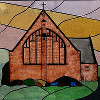Folklore & Traditions
a few reflections by Canon Dean Fostekew
There is, think, something about the darker months of the year that seems to engender the creation of different traditions. Halloween is almost upon us with the more modern and American tradition of ‘trick or treat’. Based on the ancient Scottish and Celtic tradition of Samhain, which pre-dates Christianity, it was a time when our ancestors believed that the veil between the living and the dead was very thin and it was all about remembering and commemorating the dead. It also confronted death with humour and ridicule, to help keep that “other world” at bay. The Christian practice of keeping All Saints and All Souls Days on the 1st and 2nd November grew out of this tradition with Halloween becoming ‘All Hallows Eve’ - the preparation for the celebration on the 1st November, when a festival Mass would have been said and a party followed.
The 31st October was also the start of the Celtic New Year and not about ‘ghosties and goulies’, however many of you will remember the tradition of ‘guising’ at Halloween. Guising is all about disguise. On Halloween, when it was believed that spirits could walk among the living, people dressed up to protect themselves. If a spirit came looking for you, it might not recognise you. Guising door-to-door was also a way of building social bonds and relieving community tensions. It was always meant to be a bit of fun. I suspect the ‘trick or treat’ aspect came from this knocking on doors and hoping for a warm welcome. A bit like carol singing, if you performed well you got a treat!
For me, growing up in the South of England, guising and Halloween was a bit of a mystery when I came to Scotland. At this time of the year I was more familiar with Bonfire Night. I can remember children making ‘guys’ to burn on the bonfire and collecting money to buy fireworks. This was well before Health and Safety crossed anyones mind! On the 5th November the people from my local community gathered in the old kiln area and an enormous bonfire would be lit. As the fireworks filled the skies we would enjoy playing with sparklers and eating jacket potatoes filled with butter that had been cooked in the flames. But, I wonder how many folk associated the fun with the attempt to blow James VI to bits in Parliament in 1605?
As November moves in to December we have more traditions associated with light and the light returning to the dark world. For Christians this was to herald the coming birthday of Jesus Christ and to celebrate the fact that He is the light of our world. One only has to think of the Advent Ring - perhaps some of you remember its annual creation on Blue Peter? - with an additional candle lit every Sunday in Advent and the final candle lit on Christmas Day. No doubt you’ll hear more about theses traditions in the coming weeks.
What are the traditions you most remember associated with this time of the year?
